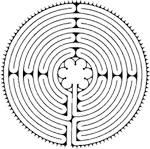Directions to Make a Labyrinth
Few things are more rewarding than to create a labyrinth and walk it afterwards. The love and care that go into the building - and in the walking - add to the transformative benefits of the labyrinth.
This part of the website will teach you how to make your own labyrinth. Currently, we have just directions for the Masking Tape Chartres Labyrinth. In the future, we will be adding Baltic, Classical, and Concentric labyrinth directions as well as tips for use of materials and other information to help you in your labyrinth-building efforts.
2 Determining the Measurements

Before beginning, you must determine the size of your labyrinth and make a guide rope that will be essential in laying out the pattern. There are 12 concentric circles in the labyrinth, enclosing 11 paths, or circuits. If you were to measure the labyrinth from edge to edge, directly through the center, you would first encounter 11 circuits, then the center, and then 11 circuits again on the other side. For calculating the diameter, then, you have the center plus 22 circuits.
The center is one-fourth the diameter of the entire labyrinth (not counting the lunations, which are the little circular shapes around the perimeter). The paths, therefore, occupy three-fourths of the diameter. Suppose, for example, that you are considering having the circuits three feet wide. First you multiply: 22 x 3 = 66. That represents the diameter of the paths, which comprises three-fourths of the diameter. To find the value of the center, the remaining one-fourth, you simply divide the three-fourths measurement by three, which gives you one-fourth. In this instance, three-fourths equals 66 feet, so dividing by three will yield the answer of 22 feet for the center. Thus, the diameter of a labyrinth with three-foot-wide paths equals 66 feet (the paths) plus 22 feet (the center) for a total of 88 feet. If you make lunations, add another four feet to the diameter, yielding 92 feet.
You can also calculate backwards. Suppose your space is 40 feet across, and you want to leave a little room around the edge of the labyrinth. Start with 36 feet as your intended diameter. Divide by four, finding that one-fourth equals nine feet. That will be the size of the center. The remaining 27 feet (36 feet minus 9 feet) will be the total width of the 22 circuits. By dividing, you find that one circuit equals approximately 14 3/4 inches. Adding the lunations, the total diameter comes out to approximately 38 ½ feet.
Once you know the path width and the diameter of the center, you are ready to make your measuring rope. Or, you could use a standard metal tape measure if you prefer. The tape measure isn't likely to stretch, as the rope might. Whichever you use, we'll just call it the guide. The guide will stretch from the center of the labyrinth to the perimeter, plus a few feet. On the guide you mark off the location of the 12 lines that form the labyrinth. In the case of the 36-foot labyrinth, remember that although the center is nine feet in diameter (all the way across) you are measuring the radius (starting at the center of the circle), which is half the diameter. Therefore, the measurement from the center to the first circle would be four and one-half feet. That's 54 inches. If you are using a rope, make a loop at the end before making your marks. You will need the loop to attach to the center pole.
